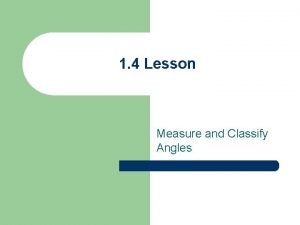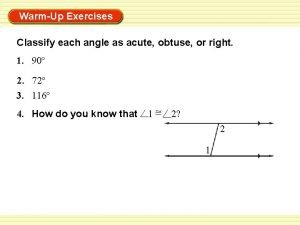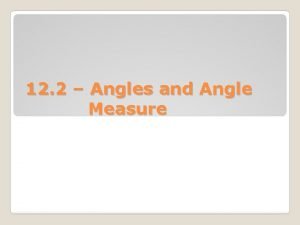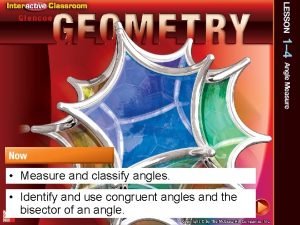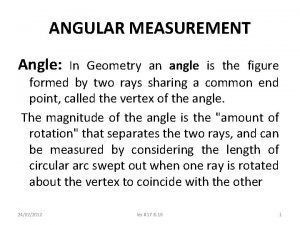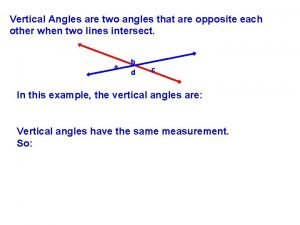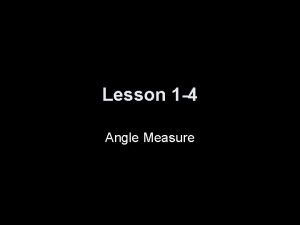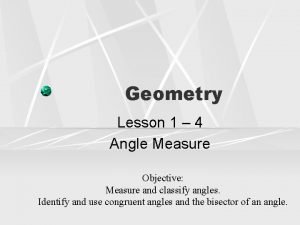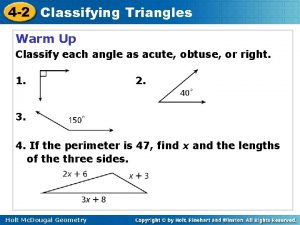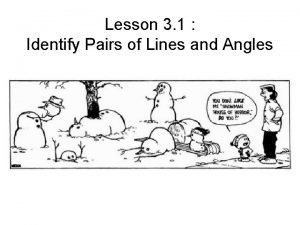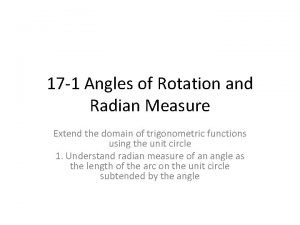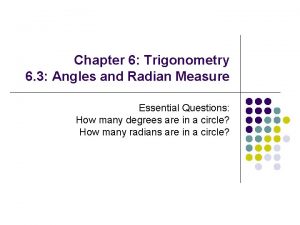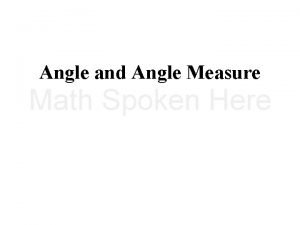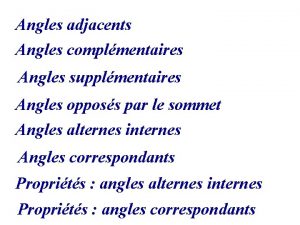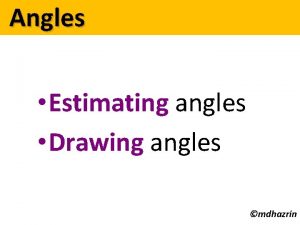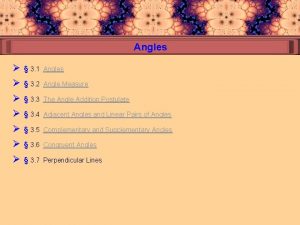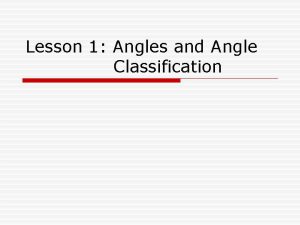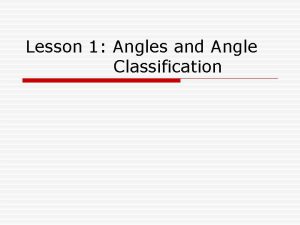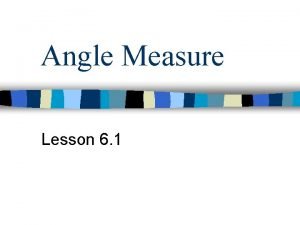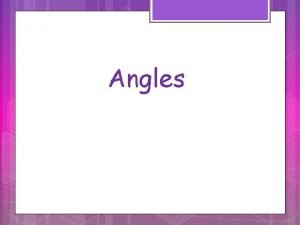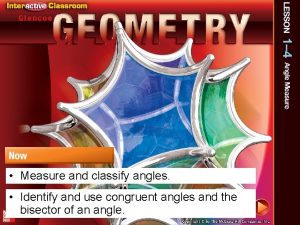1 4 Lesson Measure and Classify Angles Angle




















- Slides: 20

1. 4 Lesson Measure and Classify Angles

Angle, Vertex, and Sides an angle consists of two rays that share the same endpoint. The point where the rays intersect is called the vertex of the angle. The two rays are called the sides of the angle.

Naming Angles Name three angles in diagram. Name this one angle in 3 different ways. WXY, WXZ, and YXZ What always goes in the middle? The vertex of the angle

Classifying Angles

EXAMPLE 1 Use the diagram to find the measure of the indicated angle. Then classify the angle 55 acute a. 125 obtuse b. 180 straight c. 90 right d.

Angle Addition Postulate If D is in the interior of <ABC, then <ABD + < DBC = <ABC Adding the 2 angle together gives you the big angle

EXAMPLE 2 Find angle measures ALGEBRA Given that m and m MKN. o LKN =145 , find m LKM SOLUTION STEP 1 Write and solve an equation to find the value of x. m LKN = m LKM + m MKN o o 145 = (2 x + 10)o + (4 x – 3) 145 = 6 x + 7 138 = 6 x 23 = x Angle Addition Postulate Substitute angle measures. Combine like terms. Subtract 7 from each side. Divide each side by 6.

EXAMPLE 2 Find angle measures STEP 2 Evaluate the given expressions when x = 23. m LKM = (2 x + 10)° = (2 23 + 10)° = 56° m MKN = (4 x – 3)° = (4 23 – 3)° = 89° ANSWER So, m LKM = 56° and m MKN = 89°.

GUIDED PRACTICE Find the indicated angle measures. 3. Given that KLM is straight angle, find m and m NLM. KLN SOLUTION STEP 1 Write and solve an equation to find the value of x. m KLM + m NLM = 180° (10 x – 5)° + (4 x +3)°= 180° 14 x – 2 = 180 14 x = 182 x = 13 Straight angle Substitute angle measures. Combine like terms. Subtract 2 from each side. Divide each side by 14.

GUIDED PRACTICE STEP 2 Evaluate the given expressions when x = 13. m KLM = (10 x – 5)° = (10 13 – 5)° = 125° m NLM = (4 x + 3)° = (4 13 + 3)° = 55° ANSWER m KLM = 125° m NLM = 55°

Angle Bisector A A line which cuts an angle into two equal halves The blue ray on the right is the angle bisector of the angle on the left. The red ray on the right is the angle bisector of the angle on the left.

EXAMPLE 3 Double an angle measure In the diagram at the right, YW bisects o m XYW = 18. Find m XYZ, and SOLUTION By the Angle Addition Postulate, m XYZ = m XYW + m WYZ. Because YW bisects you know that XYW ~ WYZ. So, m M XYW = m WYZ, and you can write XYZ = m XYW + m WYZ = 18° + 18° = 36°. XYZ

Example 3 In the diagram below, YW bisects , and . Find .

Example 4

Angles Formed by the Intersection of 2 Lines Click Me!

Linear Pair A linear pair is formed by two angles that are adjacent (share a leg) and supplementary (add up to 180°) “forms a line”

Vertical Angles A pair of non-adjacent angles formed by the intersection of two straight lines “When you draw over the 2 angles it forms an X”

EXAMPLE 4 Identify angle pairs Identify all of the linear pairs and all of the vertical angles in the figure at the right. SOLUTION To find linear pairs, look for adjacent angles whose noncommon sides are opposite rays. ANSWER 1 and 4 are a linear pair. are also a linear pair. 4 and To find vertical angles, look or angles formed by intersecting lines. ANSWER 1 and 5 are vertical angles. 5

Example 5 Two angles form a linear pair. The measure of one angle is 5 times the measure of the other. Find the measure of each angle.

Example 6 Given that m 5 = 60 and m 3 = 62 , use your knowledge of linear pairs and vertical angles to find the missing angles.
 Geometry lesson 1-4 angle measure answers
Geometry lesson 1-4 angle measure answers Angles
Angles Properties of vertically opposite angles
Properties of vertically opposite angles Draw an angle with the given measure in standard position
Draw an angle with the given measure in standard position Lesson 4 classify angles
Lesson 4 classify angles Vertical angles
Vertical angles Lesson 4 classify angles
Lesson 4 classify angles We can use angle guage with a sine bar to measure angles
We can use angle guage with a sine bar to measure angles Obtuse vertical angles
Obtuse vertical angles Angle addition postulate and angle bisector
Angle addition postulate and angle bisector Module 15 lesson 1 central angles and inscribed angles
Module 15 lesson 1 central angles and inscribed angles Lesson 4-2 angles and angle bisectors
Lesson 4-2 angles and angle bisectors Solve for unknown angles lesson 8
Solve for unknown angles lesson 8 Lesson 1-4 angle measure
Lesson 1-4 angle measure Geometry lesson 1-4 angle measure answers
Geometry lesson 1-4 angle measure answers Uses of wind vane
Uses of wind vane How to classify triangles by angles
How to classify triangles by angles Classify a triangle by its sides
Classify a triangle by its sides Name a pair of parallel lines
Name a pair of parallel lines Angles of rotation and radian measure
Angles of rotation and radian measure 6-1 angles and radian measure answers
6-1 angles and radian measure answers
